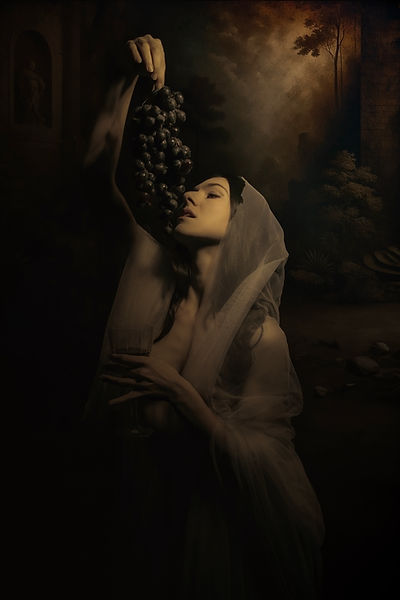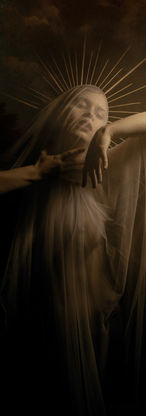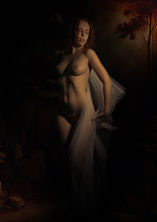Mytharia
The captivating photographic project titled "Mythic Light: Feminine Figures Across Civilizations and Ages" explores the representation of the female figure in mythology, transcending the boundaries of civilizations and eras. Inspired by the iconic chiaroscuro of Caravaggio, each shot strives to capture the mystical and timeless essence of mythological goddesses and heroines. Subtle interplays of light and shadow create a surreal atmosphere, evoking both the power and vulnerability inherent in these iconic figures. Each photograph becomes a visual exploration, revealing the multifaceted nature of mythical femininity, from the grace of Aphrodite to the strength of the warrior goddess. Through this series, the project aims to transcend time and celebrate the diversity of female archetypes that have shaped our collective imagination throughout the centuries.

The Holy Virgin
The Virgin Mary, an iconic and revered figure in Christian tradition, embodies the epitome of sacred motherhood and purity. Hailed as the Mother of God, she is admired for her unwavering faith and humble acceptance of the announcement of Christ's birth. Artistic representations of the Virgin Mary, as seen in classical paintings, often depict her with an aura of grace and serenity, surrounded by symbols of her holiness. Her role in Scriptures as a loving and compassionate mother has captivated believers throughout the centuries, inspiring deep devotion. Beyond her religious significance, the figure of the Virgin Mary continues to evoke cultural and artistic fascination, serving as a muse for countless artists and embodying an ideal of sacred femininity.
Persephone
Persephone, a central figure in Greek mythology, is a captivating and complex goddess whose narrative reflects the cyclical nature of life, death, and rebirth. As the daughter of Demeter, the goddess of agriculture, Persephone is known for her abduction by Hades, the god of the underworld. Her story encompasses both tragedy and resilience, as she becomes the Queen of the Underworld but also experiences the anguish of separation from her mother. Persephone's myth has been interpreted in various ways, symbolizing the changing seasons and the inevitability of death and renewal. Artists and writers have been inspired by her tale, capturing the dichotomy of her dual roles as a youthful, blooming goddess and a powerful queen in the realm of the dead. Persephone embodies the complexity of feminine archetypes, representing both vulnerability and strength, and her myth continues to resonate as a profound exploration of life's inherent dualities.


Circe
Circe, a mesmerizing enchantress from Greek mythology, is a compelling and enigmatic figure whose story is steeped in magic and transformation. Known for her exceptional skills in sorcery, Circe is often depicted as a captivating and powerful witch living on the mythical island of Aiaia. Her encounter with Odysseus in Homer's "Odyssey" is a pivotal moment, where she transforms his men into swine but later becomes an ally and lover. Circe embodies the allure and danger associated with the mystical, showcasing the ambiguous nature of magic in Greek mythology. Her character symbolizes the transformative power of knowledge and the complexities of feminine power. Artists and writers have been drawn to Circe's mystique, portraying her as a potent enchantress with the ability to shape-shift and control the elements. The myth of Circe invites contemplation on the intersection of power, desire, and the supernatural in ancient storytelling, making her a fascinating and enduring figure in mythological lore.
Kali
Kali, the formidable and dynamic goddess in Hindu mythology, is a manifestation of the divine feminine force that encompasses both creation and destruction. Often depicted with multiple arms, wielding weapons, and standing over the defeated form of the demon Mahishasura, Kali symbolizes the relentless power of time and the cosmic cycles of life, death, and rebirth. Her dark complexion represents the unmanifested, primordial energy from which the universe emerges, while her fearsome appearance signifies the destruction of ego and ignorance. Despite her formidable visage, Kali is also revered as a nurturing mother, embodying both fierce protection and unconditional love. Devotees worship Kali for strength, transformation, and liberation from the material world. The imagery of Kali has inspired artists, writers, and spiritual seekers, evoking contemplation on the paradoxical nature of divinity and the multifaceted aspects of the feminine divine in Hindu cosmology.


Uzume
Uzume, a lively and joyful goddess in Japanese mythology, holds a unique place as the Shinto deity of mirth and revelry. Celebrated for her role in the well-known myth of the Amaterasu Omikami, Uzume is credited with bringing the sun goddess out of her self-imposed seclusion, restoring light to the world. Uzume's spirited and playful nature is exemplified in the myth where she performs a lively dance, exposing herself in a whimsical manner, to make the other gods laugh. This act of merriment succeeds in coaxing Amaterasu from her hiding place, symbolizing the power of joy to dispel darkness and bring about renewal. Uzume is venerated for her ability to uplift spirits, fostering a sense of unity and shared laughter. Her mythology reflects the importance of joy, spontaneity, and the communal aspects of celebration in Japanese culture. Uzume's character stands as a testament to the belief in the transformative and uplifting power of mirth within the rich tapestry of Japanese mythology.
Caryatides
Each model becomes a contemporary caryatid, carrying on her shoulders the symbolism of mythological goddesses. These images captivate by transforming each woman into a living sculpture. Each of these photos represents a modern incarnation of the strength, grace, and determination associated with specific goddesses. Inspired by the characteristic chiaroscuro style of Caravaggio, these images bestow upon each caryatid a surreal aura. These photos aim to transcend the contemporary by integrating mythological symbolism into a captivating visual language, thereby creating living caryatids that bear not only the aesthetic weight but also the profound significance of mythological heritage.

























